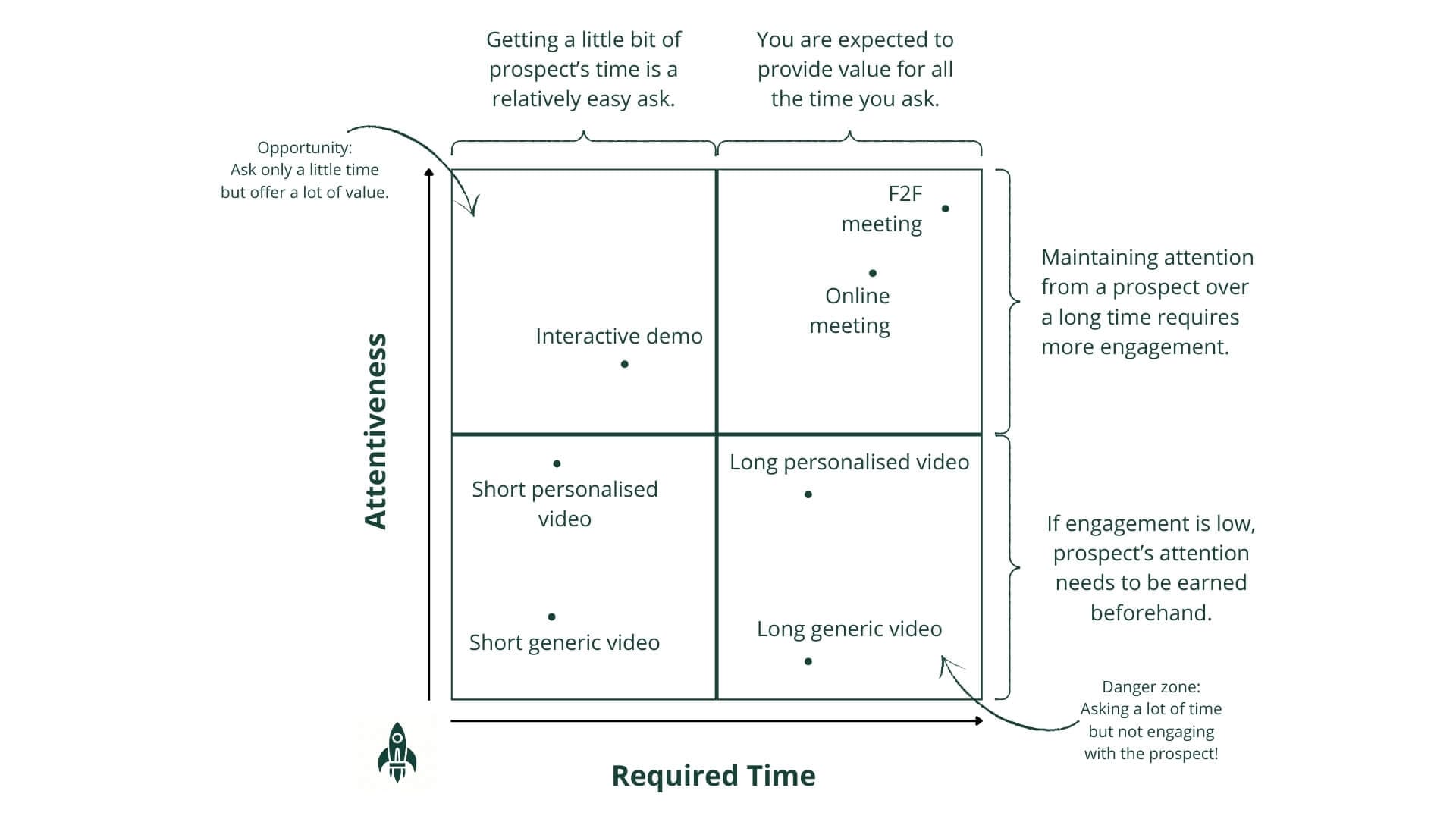How to Run a Great Sales Demo
A great sales demo is critical to winning new customers. We provide guidelines on how to master sales demos in F2F or online meetings when selling SaaS products.

Demonstration of the SaaS product is a critical component of winning new customers. There are at least three ways to demo a SaaS product to prospective buyers. This article focuses on mastering a sales demo in a face-to-face or online meeting.
The advantage of doing live sales demos in meetings is that all participants can attend simultaneously, allowing real-time question addressing. Moreover, these meetings offer numerous nonverbal cues, especially face-to-face, to estimate how well the message is received. The face-to-face format tends to capture the majority, if not all, of the audience's attention, leading to high engagement.

A great sales demo involves preparing well, mastering the demonstration, and neatly wrapping up. Let’s examine these components individually.
Preparations for the Sales Demo
Never do a sales demo without preparations. By the bare minimum, one should know beforehand:
- Company: Basics about the prospective company, such as what they do, which industry they are in, and any recent notable news like a new C-level hire or an announcement of a recent funding round.
- Attendees: Who is attending the sales demo, what are their roles and responsibilities, and how has your company helped similar persons before? LinkedIn and Google are good friends of yours.
- History: According to the CRM, have there been interactions between your companies before? Maybe they have evaluated your offering before, or one of the decision-makers is a former customer.
Assuming is the enemy of understanding. Prepare accordingly, but do not fall into the trap of making big bets without at least confirming your findings or presumptions from the prospects directly.
You need to understand prospects' problems and pains.
Before the demo, either on a separate discovery call or before moving to the sales demo part of a sales call, learn about who you meet with. What you need to know depends on your offering, but discussing roles, challenges, goals and possibly tech stacks should get you on the same page as the prospects. To qualify a lead or prospect, you can lean into the CHAMP framework, but most importantly, you need to understand prospects' problems and pains. Your sales demo will be a bunch of nice-to-have features unless you know the changes your to-be-customer wants to achieve.
You can personalise and customise the sales demo per prospect based on your preparations. These can be done at the decision-maker or company level. On a decision-maker level, the demo focuses on how the role in question benefits from the relevant features, and on a company level, the data and branding used during the demo can match those of the company in question. No matter how you personalise or customise the demo, the main goal is to make it easy for prospective companies to see themselves using the product. Changing logos and branding might be preferred for some sales demos, but others might be personalised well enough by the account executives explaining the critical features.
The main goal is to make it easy for the prospective company to see themselves using the product.
More generally, practising and planning sales demos are the keys to long-term success. You and your colleagues should have a plan to demonstrate the product and all its features. The sales team needs to know new and old features to explain and show them to prospects and jump between them smoothly as the demo requires.
Conducting a Winning Sales Demo
And then you meet with the prospects.
During the show time, the pacing of the meeting is super important. To maintain prospects' attention and keep high energy levels during the call, consider these guidelines:
- Call structure: The sales demo should take no more than 50% of your time together. The rest is reserved for setting up the stage, doing discovery, answering questions, handling objections, and agreeing on the next steps.
- Start on a high note: Long discovery and slides of your company make prospects snooze and start multitasking before a demo begins. Prospects are there to see how their problems are solved. If you need to do a long discovery, it’s probably best done on another call.
- Be mindful of the agreed-upon time: If you have 45 minutes together, use a max of 45 minutes; don't go over time. With 45 minutes, your demonstration can take about 20 minutes. You probably must prioritise what to demo, so focus on the most essential features to the prospect.
The sales demo should take no more than 50% of your time together.
A sales demo is conducted by a sales professional. If the session would be just you talking, it could be a video recording for the prospect to watch independently. Your personality, high engagement, and lively conversation are weapons that move the opportunity forward. People buy from people, after all. High engagement also reduces the chance that your prospects' attention drifts away and multitasking begins. At the beginning of the demo call, spend a minute recapping previous conversations and bringing possible new attendees up to speed, making some additional discovery, and setting the stage for the demo. Then go for it!
Your conversation during the demo should move the prospects towards their aha! moment. Remind the prospects about the pain you are there to solve and explain how and why the features you are showing do just that. Do not trust that prospect to do the 1+1 math themselves. Confirm they got it, but do not just say, “Does this make sense?” every two minutes. Ask more engaging questions, like whether they see the feature as something their team could quickly learn to use or something that helps with their problem.
Why are these features essential?
Two points to keep in mind during the dialogue. First of all, a good practice for the discussion is always to explain "why." Why do you show something? Why are these features essential? Why has your company selected a different approach to competition? Secondly, make sure you and your prospects speak the same language. Do not use internal company jargon; that is a sure way to create a disconnect between buyer and seller. If possible, use the same terminology as your prospects use.
Most importantly, the topic of the conversation should not be the product. It should be your prospect's business and solving their pains and problems. Your product might have excellent features, but not all of them are important to everybody. Those solving the challenge your current prospects are having are. Everything else is noise.
When your dialogue with prospects during the demo focuses on them and why, you are playing the game at least one step above the competition!
Wrapping Up the Sales Demo
Once you are done with the demo part, you should move to check off the following items:
- Questions and objections: After the demo, there will probably be some questions or objections. Make sure you have time to address these.
- Mutual understanding: Recap the problem and how you solved it. Confirm that you both agree on this! You can then use this acknowledgement to move the conversation forward during the next steps.
- Next steps: Ask for permission to follow up and confirm that the prospects are interested in the next steps. Lay them out and get a buy-in.
Recap the problem and how you solved it. Confirm that you both agree on this!
Once the call ends or you have left the prospect's premises, consider two things to stand out from the competition. As with the sales demo, your follow-up should be about the prospect's business, not yours. So, a must-have is a recap (yes, again) of customers' pain and how you solve it. Additionally, not all the decision-making unit members attended the sales demo. You can help prospects facilitate their internal dialogue by including a short video recap of how your product solves their primary problem. This video might be all you need to convince the people behind the scenes.
And before we close, let’s take a bird's-eye view for a second. Sales are much like sports: rise, demo, rest and repeat. To improve your demoing, ask for feedback from your colleagues, bosses, customers, or prospects on what you do well and what could be improved. Do this in addition to evaluating your performance yourself, too. Improve your weaknesses in the following demo calls or practice sessions to become a lean, mean sales demo machine.
A sales demo is at its best when both the seller and the buyers leave more energised than when they went in.
With these sales demo guidelines, you should succeed in SaaS sales demos and outpace your competition and colleagues. A sales demo is at its best when both the seller and the buyers leave more energised than when they went in. Energy builds momentum, and momentum wins the day.




